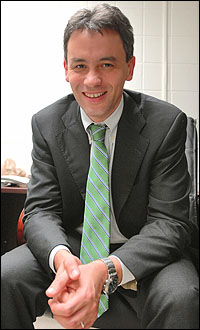Archives
Melodia joins engineering faculty
New assistant professor working on wireless sensor networks
By KEVIN FRYLING
Reporter Staff Writer
While the end-of-the-semester crunch is bearing down on everyone in the university community, Tommaso Melodia, who joined the UB faculty this fall as an assistant professor in the Department of Electrical Engineering, School of Engineering and Applied Sciences, says a new home, a new job and a new baby all within the past few months have made the time since his arrival at UB a constant whirlwind of activity.

It’s been a hectic fall for
Tommaso Melodia—a new job, a new home
and a new baby, all within the past few months.
PHOTO: NANCY J.
PARISI
The first few weeks of the semester were spent literally flying back and forth from Buffalo to Atlanta until his wife, Violetta, and newborn daughter, Ludovica, could join him in their new home in Clarence. Melodia notes he arrived in Buffalo in late August, only a few days after his daughter was born. But as life finally starts settling into new routines, he says he’s eager to pick up the work he began as a researcher of communication protocols for wireless sensor networks and underwater acoustic devices at the Georgia Institute of Technology.
“I’m working on so-called ‘wireless sensor networks’—basically wireless networks of tiny devices that are resource-constrained in terms of processing capabilities, communication capabilities and battery power,” he says. “I’m fascinated by problems like the self-organization of these devices—designing algorithms that will allow these devices to self-organize in an optimally performing network without human beings having to configure everything.”
The potential applications of simple, inexpensive devices able to collect, communicate and react to complex information detected in the environment are vast, Melodia adds, noting that moving from complex sensor networks that require miles of electrical wire and constant human oversight—corporate security systems, for example—in favor of smart and efficient ad-hoc wireless systems will open the door to everything from lightweight, multisensory surveillance systems for guarding against chemical attacks and rerouting traffic congestion to devices that could transmit information about a patient’s vital signs or broadcast data on ocean currents in order to investigate global warming.
“Surveillance, both in military and civilian settings, is probably the killer application for this,” he adds. “If it were to be properly regulated, you could store potentially relevant activities”—such as information from suspicious activities like thefts—“and make it available for future queries.”
Melodia explains that the wireless communication problems on which he works fall into two broad subcategories: terrestrial wireless networks—a familiar form of wireless communication that exploits the properties of electromagnetic waves for communication purposes, similar to television transmission—and underwater acoustic networks—a form of wireless communication that uses “waves of pressure,” or sound waves, whose slow speed relative to electromagnetic waves renders protocols designed for the land-based wireless communication inefficient or inapplicable.
“Underwater acoustics is actually one of the most interesting parts of this research from a telecommunication perspective,” says Melodia, who in 2005 co-authored an influential paper on the research challenges engineers must overcome to develop affordable and sophisticated underwater sensor networks. “It would be too much to say we started the field,” he says, “but it certainly inspired a lot of people.”
Melodia is working with several UB graduate students as director of the Wireless Networks and Embedded Systems Lab that he’s establishing on the third floor of Bonner Hall. Experiments are being run using mathematical models and computer simulations, he says, but points out that his ultimate goal is to partner with research institutions using sensor networks in the field in order to perform a combination of theoretical and hands-on experimental research.
“This field is usually based on computer simulations because it’s so time-consuming and expensive to implement communication protocols in real devices,” he says, “but there’s usually a big gap between computer simulations and mathematical models, and what you actually get when you do experiments—the research community has understood this in the last couple of years and is trying to fill that gap by deploying more and more experimental testbeds.”
Also on his schedule this semester is an undergraduate course on signal analysis and transform methods, in which he teaches electrical and computer engineering majors some of the fundamental mathematical concepts behind systems engineering.
“It’s a lot of fun to interact with students,” he says, noting that this semester is the first time he’s taught a course he has designed himself from start to finish despite years spent in front of a classroom as a graduate student. “There are some really bright students,” he adds. “I’m learning a lot and I’m really enjoying it.”
The recipient of a degree equivalent to a joint bachelor’s and master’s of science in telecommunication engineering and a doctorate in information and communication engineering from the University of Rome la Sapienza in Rome, Italy, Melodia came to the United States in 2004 to earn a doctorate in electrical and computer engineering from Georgia Tech.
“I never planned on going to the United States for the rest of my life or even spending time here as a researcher,” he recalls, “but then, I had the opportunity to spend a few months at Georgia Tech and a professor I was working with asked if I wanted to get a Ph.D. It was really what I was looking for—a challenging environment where I could grow as a researcher.”
The desire to grow further as a researcher also brought him to UB, he adds, noting that communication and signal processing is one of the three major research strengths of the Department of Electrical Engineering—the others being energy systems and nanoelectronics.
“What brought me here is the fact that there’s a strong electrical engineering department and specifically a strong telecommunications group,” he says. “I also see a lot happening in the university as a whole. It’s a place that’s trying to grow and trying to do something—it’s good to be in an environment like this.”
